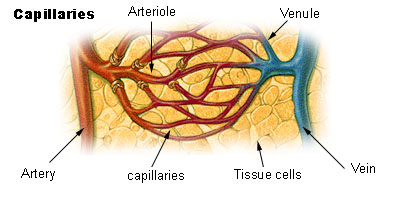Capillary

|
WikiDoc Resources for Capillary |
|
Articles |
|---|
|
Most recent articles on Capillary |
|
Media |
|
Evidence Based Medicine |
|
Clinical Trials |
|
Ongoing Trials on Capillary at Clinical Trials.gov Clinical Trials on Capillary at Google
|
|
Guidelines / Policies / Govt |
|
US National Guidelines Clearinghouse on Capillary
|
|
Books |
|
News |
|
Commentary |
|
Definitions |
|
Patient Resources / Community |
|
Patient resources on Capillary Discussion groups on Capillary Directions to Hospitals Treating Capillary Risk calculators and risk factors for Capillary
|
|
Healthcare Provider Resources |
|
Causes & Risk Factors for Capillary |
|
Continuing Medical Education (CME) |
|
International |
|
|
|
Business |
|
Experimental / Informatics |
Editor-In-Chief: C. Michael Gibson, M.S., M.D. [1]
Capillaries are the smallest of a body's blood vessels, measuring 5-10 μm, which connect arterioles and venules, and are important for the interchange of oxygen, carbon dioxide, and other substances between blood and tissue cells.[1]
Structure
The walls of capillaries are composed of only a single layer of cells, the endothelium. This layer is so thin that molecules such as oxygen, water and lipids can pass through them by diffusion and enter the tissues. Waste products such as carbon dioxide and urea can diffuse back into the blood to be carried away for removal from the body.
Capillary permeability can be increased by the release of certain cytokines.
Transport across endothelium
The endothelium also actively transports nutrients, messengers and other substances.
Large molecules may be too big to diffuse across endothelial cells. In some cases, vesicles contained in the capillary membrane use endocytosis and exocytosis to transport material between blood and the tissues. Blood hydrostatic pressure varies along the length of the capillar, and is roughly 40 mm Hg at the atreiolar end and 15 mm Hg at the venus end. The opposing force from outside the capillary is osmotic pressure and is 25 mm Hg. The result is an outward movement of fluid and ions at the atreiolar end, and an influx of fluid at the venus end of the capillary.
Immune response
In an immune response, the endothelial cells of the capillary will upregulate receptor molecules, thus "catching" immune cells as they pass by the site of infection and aiding extravasation of these cells into the tissue.
Capillary bed
The "capillary bed" is the network of capillaries supplying an organ. The more metabolically active the cells, the more capillaries it will require to supply nutrients.
The capillary bed usually carries no more than 25% of the amount of blood it could contain, although this amount can be increased through autoregulation by inducing relaxation of smooth muscle.
The capillaries do not possess this smooth muscle in their own walls, and so any change in their diameter is passive. Any signalling molecules they release (such as endothelin for constriction and nitric oxide for dilation) act on the smooth muscle cells in the walls of nearby, larger vessels, e.g. arterioles.
Types
Capillaries come in three types:
- Continuous - Continuous capillaries have a sealed endothelium and only allow small molecules, water and ions to diffuse.
- Fenestrated - Fenestrated capillaries (derived from "fenestra," the Latin word for "window") have openings that allow larger molecules to diffuse.[2]
- Sinusoidal - Sinusoidal capillaries are special forms of fenestrated capillaries that have larger openings in the epithelium allowing red blood cells and serum proteins to enter.
See also
References
- ↑ Template:KMLEref
- ↑ Histology image: 22401lba – Histology Learning System at Boston University
External links
- Histology image: 00903loa – Histology Learning System at Boston University
da:Kapillær
de:Kapillare
is:Háræð
it:Capillare
he:נים (כלי דם)
lv:Kapilāri
lt:Kapiliaras
nl:Haarvat
no:Kapillær
simple:Capillary
sr:Капилар
fi:Hiussuoni
sv:Kapillär